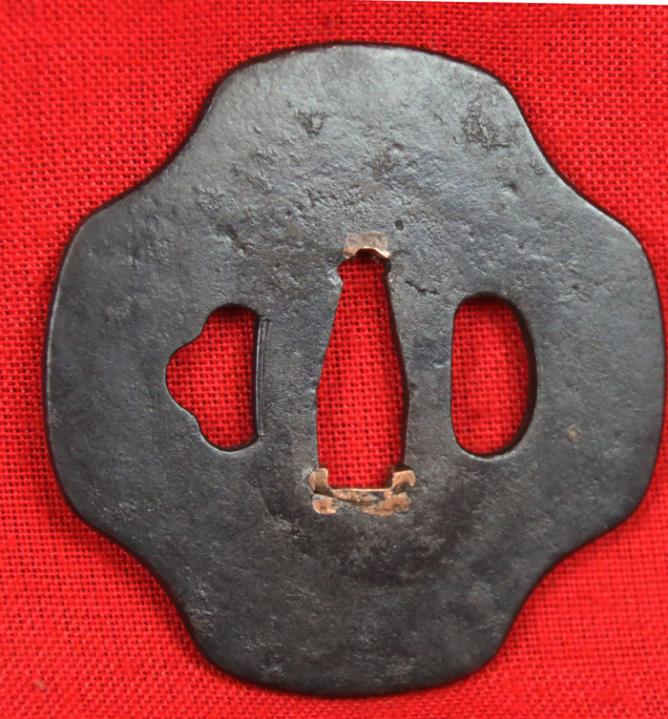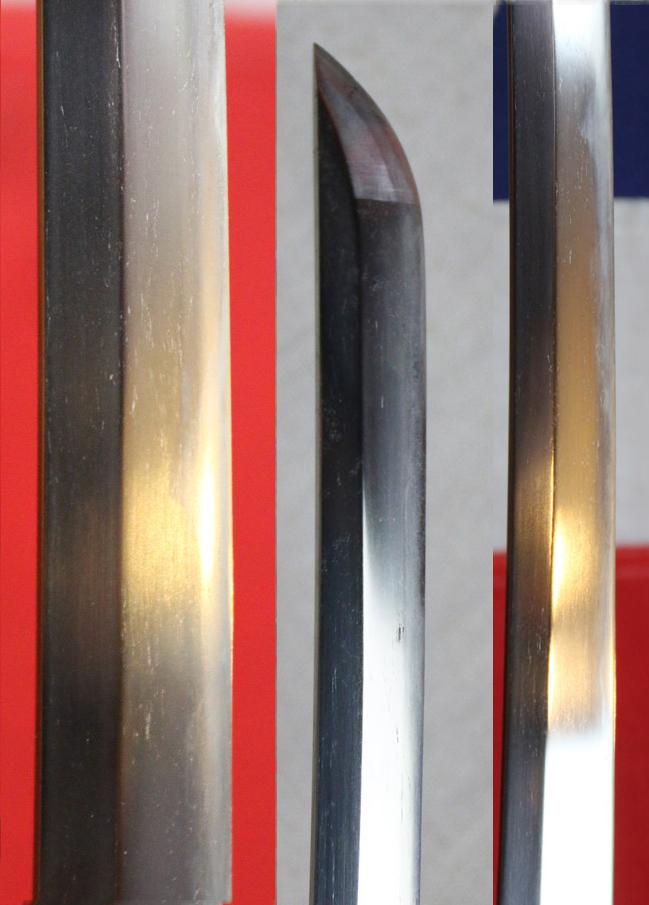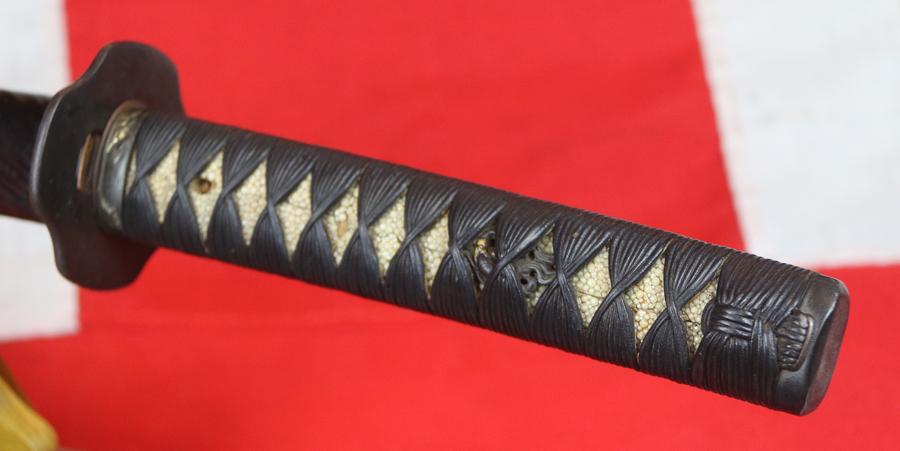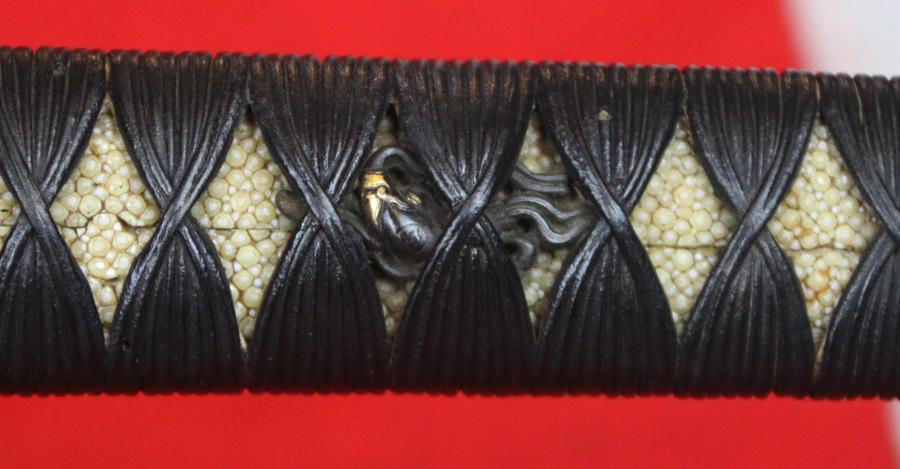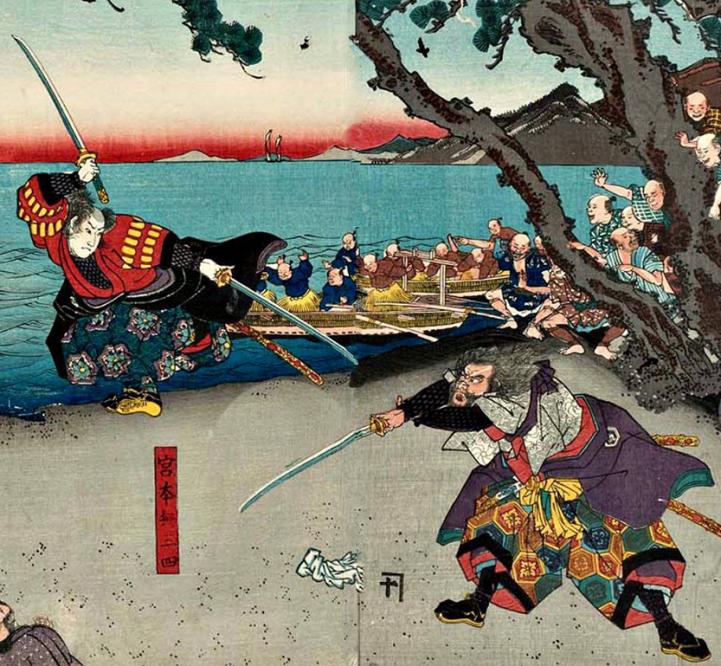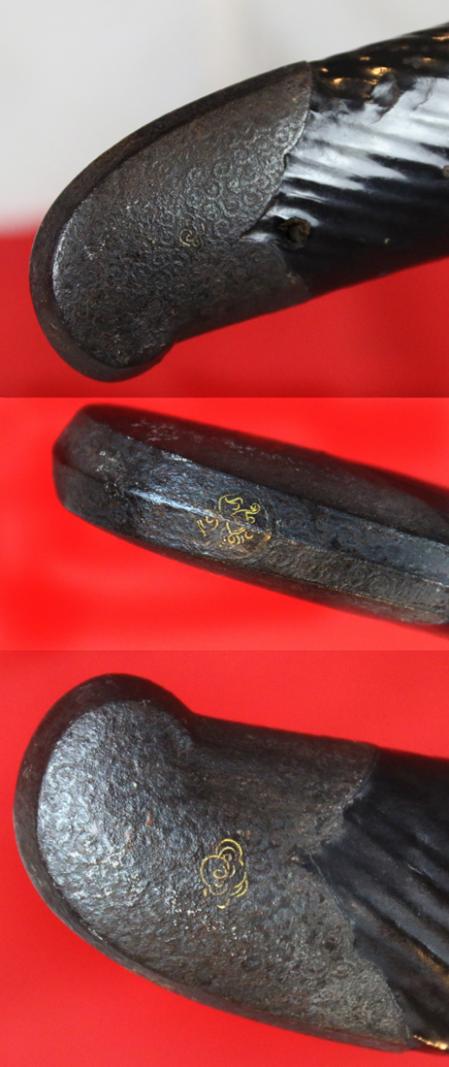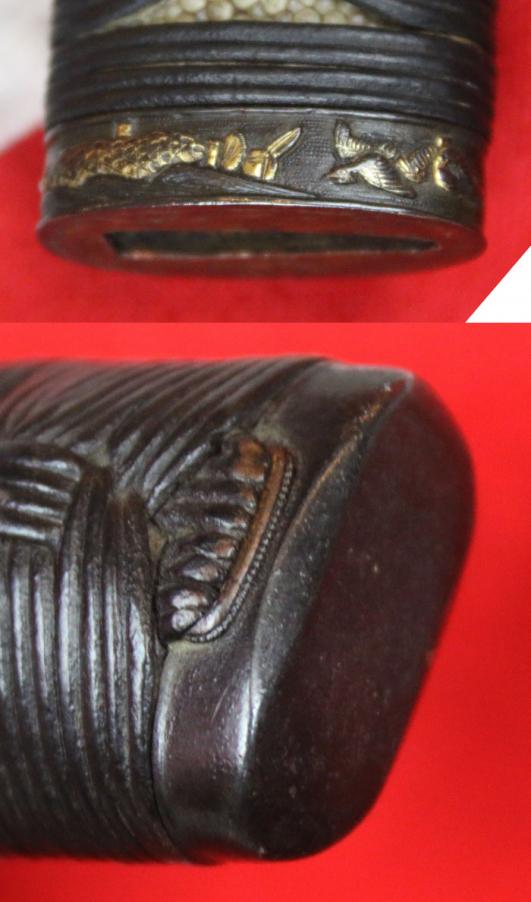An Ancient & Stunning Sengoku Period Samurai Katana Over 500 Years Old, With A Beautiful and Most Elegant Blade & Fabulous Original Edo Fittings
The swords fittings have been absolutely untouched for around 200 years, since before it came over to England in the late 1870's.
A superb ancient 500 year old koto bladed sword, of very light balance, perfect for two handed sword combat, with beautiful and elegant funbari graduating curvature and partial narrow based hamon typical of ancient koto blades and very beautiful indeed. Very fine gold and shakudo fuchi with fine gold inlaid menuki, shaped early Edo iron tsuba, lacquered black copper kashira. Fabulous saya with stunning original antique spiral form of finest urushi lacquer, and a superb early iron sayajiri of an iron court cap style engraved with fine curlicues and gold inlay including a clan mon.
Wonderful organic tsukaito of flexible hardened black binding.
The great samurai warrior Musashi, who was a famous exponant of two handed sword fighting and used two swords just as this one. Miyamoto Musashi 1584 – June 13, 1645), also known as Shinmen Takezo, Miyamoto Bennosuke or, by his Buddhist name, Niten Doraku, was an expert Japanese swordsman and ronin. Musashi, as he was often simply known, became renowned through stories of his excellent, and unique double bladed swordsmanship and undefeated record in his 60 duels. He was the founder of the Hyoho Niten Ichi-ryu or Niten-ryu style of swordsmanship and in his final years authored the The Book of Five Rings, a book on strategy, tactics, and philosophy that is still studied today.
At Ganryujima in Kyushu, Miyamoto Musashi Fights Sasaki Ganryu picture in the gallery. This is now a long retired former samurai's weapon of wonder, that could naturally never be used again for the purpose for which it was made in hand to hand combat, nor should it be, but simply to be admired with awe for its elegance and its holistic beauty and features,
The Sengoku period Sengoku Jidai, "Warring States period") is a period in Japanese history of near-constant civil war, social upheaval, and intrigue from 1467 to 1615.
The Sengoku period was initiated by the Ōnin War in 1467 which collapsed the feudal system of Japan under the Ashikaga Shogunate. Various samurai warlords and clans fought for control over Japan in the power vacuum, while the Ikkō-ikki emerged to fight against samurai rule. The arrival of Europeans in 1543 introduced the arquebus into Japanese warfare, and Japan ended its status as a tributary state of China in 1549. Oda Nobunaga dissolved the Ashikaga Shogunate in 1573 and launched a war of political unification by force, including the Ishiyama Hongan-ji War, until his death in the Honnō-ji Incident in 1582. Nobunaga's successor Toyotomi Hideyoshi completed his campaign to unify Japan and consolidated his rule with numerous influential reforms. Hideyoshi launched the Japanese invasions of Korea in 1592, but their eventual failure damaged his prestige before his death in 1598. Tokugawa Ieyasu displaced Hideyoshi's young son and successor Toyotomi Hideyori at the Battle of Sekigahara in 1600 and re-established the feudal system under the Tokugawa Shogunate. The Sengoku period ended when Toyotomi loyalists were defeated at the siege of Osaka in 1615.
The Sengoku period was named by Japanese historians after the similar but otherwise unrelated Warring States period of China.
The Incredible Story of Japanese Lacquer on Samurai Swords Scabbards, called Saya
Japanese lacquer, or urushi, is a transformative and highly prized material that has been refined for over 7000 years.
Cherished for its infinite versatility, urushi is a distinctive art form that has spread across all facets of Japanese culture from the tea ceremony to the saya scabbards of samurai swords
Japanese artists created their own style and perfected the art of decorated lacquerware during the 8th century. Japanese lacquer skills reached its peak as early as the twelfth century, at the end of the Heian period (794-1185). This skill was passed on from father to son and from master to apprentice.
Some provinces of Japan were famous for their contribution to this art: the province of Edo (later Tokyo), for example, produced the most beautiful lacquered pieces from the 17th to the 18th centuries. Lords and shoguns privately employed lacquerers to produce ceremonial and decorative objects for their homes and palaces.
The varnish used in Japanese lacquer is made from the sap of the urushi tree, also known as the lacquer tree or the Japanese varnish tree (Rhus vernacifera), which mainly grows in Japan and China, as well as Southeast Asia. Japanese lacquer, 漆 urushi, is made from the sap of the lacquer tree. The tree must be tapped carefully, as in its raw form the liquid is poisonous to the touch, and even breathing in the fumes can be dangerous. But people in Japan have been working with this material for many millennia, so there has been time to refine the technique!
Flowing from incisions made in the bark, the sap, or raw lacquer is a viscous greyish-white juice. The harvesting of the resin can only be done in very small quantities.
Three to five years after being harvested, the resin is treated to make an extremely resistant, honey-textured lacquer. After filtering, homogenization and dehydration, the sap becomes transparent and can be tinted in black, red, yellow, green or brown.
Once applied on an object, lacquer is dried under very precise conditions: a temperature between 25 and 30°C and a humidity level between 75 and 80%. Its harvesting and highly technical processing make urushi an expensive raw material applied in exceptionally fine successive layers, on objects such as bowls or boxes.After heating and filtering, urushi can be applied directly to a solid, usually wooden, base. Pure urushi dries into a transparent film, while the more familiar black and red colours are created by adding minerals to the material. Each layer is left to dry and polished before the next layer is added. This process can be very time-consuming and labor-intensive, which contributes to the desirability, and high costs, of traditionally made lacquer goods. The skills and techniques of Japanese lacquer have been passed down through the generations for many centuries. For four hundred years, the master artisans of Zohiko’s Kyoto workshop have provided refined lacquer articles for the imperial household 35.25 inches long overall, 24 inch blade.
Code: 23942



